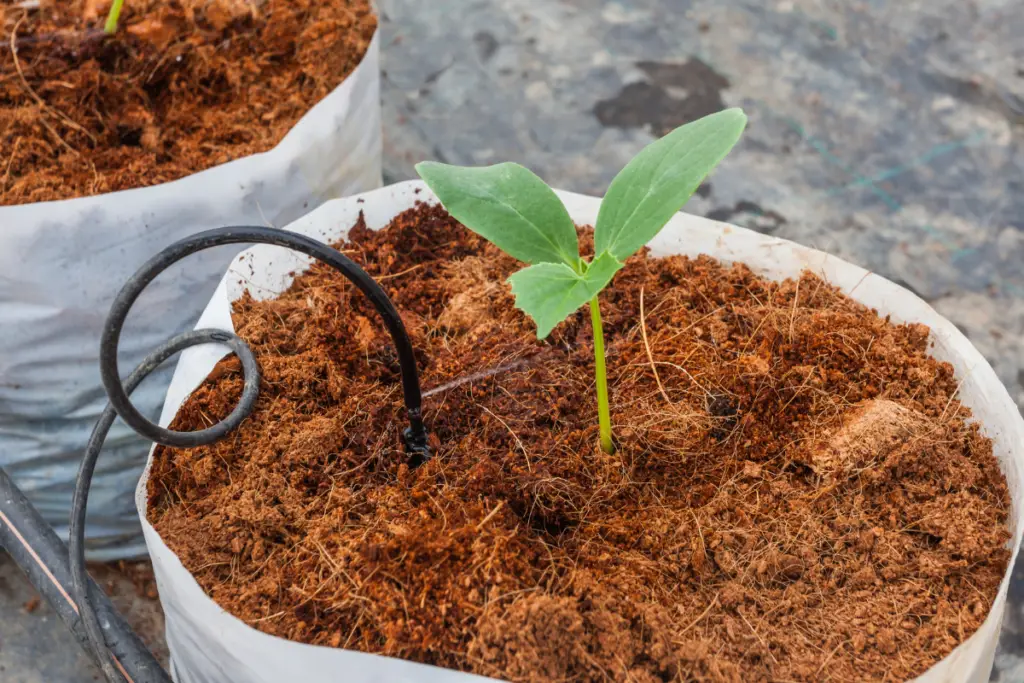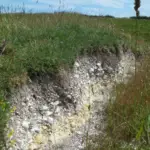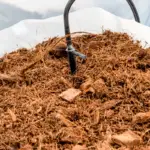Palm peat, also known as coir or coconut husk, is a potting medium that provides an alternative to traditional potting soil.
It is a by-product of the coconut industry and is made from the fibrous husk of the coconut.
It is an eco-friendly and sustainable option for gardening and is becoming increasingly popular among gardeners.
Palm peat has several benefits that make it an excellent choice for gardening.
It has high water retention, suitable aeration, and antifungal properties that ensure good germination of seeds and vigorous root, plant, and flower development.
It is also pH neutral, making it an ideal growing medium for a wide range of plants.
Additionally, palm peat is lightweight, making it easy to transport and handle, and it is renewable and biodegradable, making it an environmentally friendly option.

Table of Contents
Understanding Palm Peat
Palm peat is a growing medium that is similar to coco peat but made from palm oil rather than coconut.
It is a byproduct of the palm oil industry and is gaining popularity as a sustainable alternative to peat moss.
Palm peat is a highly absorbent material that can hold up to 10 times its weight in water, making it an ideal growing medium for plants.
Palm peat is rich in nutrients and has a pH level of 5.5 to 6.5, which is slightly acidic. It contains high levels of potassium, calcium, and magnesium, which are essential for plant growth.
Palm peat is also a good source of organic matter, which helps to improve soil structure and fertility.
Experts recommend mixing palm peat with soil in a ratio of 1:3. This means that for every one part of palm peat, three parts of soil should be used.
This mixture provides an excellent growing medium for plants and helps to improve soil quality.
Palm peat is easy to use. It comes in compressed bricks that can be rehydrated with water. To use palm peat, simply soak the brick in water for 10 minutes until it expands.
Once it has expanded, break it up and mix it with soil to create a nutrient-rich growing medium.
In summary, palm peat is a sustainable alternative to peat moss that is rich in nutrients and organic matter. It is easy to use and can help to improve soil quality and plant growth.
Origin and Production of Palm Peat
Peat is a naturally occurring sedimentary material that forms in wetlands through the partial decomposition of organic matter, primarily plant material.
Palm peat, also known as oil palm peat, is a type of peat that forms in areas where oil palm trees are cultivated.
It is a byproduct of oil palm plantation management and has been used for various purposes, including as a soil amendment, fuel, and substrate for horticulture.
Oil palm peat is formed when the oil palm plantation management practices involve draining the wetlands to reduce the water table and make the land suitable for cultivating oil palm trees.
The drained peatlands are then used for planting oil palm trees, which grow on the peat soil.
The oil palm trees absorb nutrients from the peat, and their roots also help to stabilize the soil.
The production of palm peat is a result of the increasing demand for palm oil, which is derived from the oil palm fruit.
Palm oil is used in various industries, including food, cosmetics, and biofuels. As the demand for palm oil increases, so does the need for more land to cultivate oil palm trees.
This has led to the conversion of natural forests and peatlands into oil palm plantations, resulting in the loss of biodiversity and the release of carbon stored in the peatlands.
In addition to the environmental impact, the production of palm peat also has economic implications.
The use of palm peat as a soil amendment can improve soil fertility and increase crop yields, which can benefit farmers.
However, the use of palm peat as a substrate for horticulture can also lead to the depletion of peatlands, which can have long-term consequences for the environment and the economy.
- 🌴【Coco Coir Brick】: Made of 100% natural organic coconut coir, which extracted from the husk on the outer shell of a coconut, low EC and suitable pH can provide a healthy growing environment for most flowers and plants, so it can cultivate flowers and economical plant products without soil, and can also cultivate seedlings
Prices pulled from the Amazon Product Advertising API on:
Product prices and availability are accurate as of the date/time indicated and are subject to change. Any price and availability information displayed on [relevant Amazon Site(s), as applicable] at the time of purchase will apply to the purchase of this product.
Properties of Palm Peat
Palm peat is a type of organic soil composed of partially decomposed plant material, mainly from oil palm trees.
It is a byproduct of oil palm cultivation and is commonly used as a soil amendment for agricultural purposes. Palm peat has unique properties that make it different from other types of peat.
Physical Properties
Palm peat has a dark brown to black color and a spongy texture. It is lightweight, porous, and highly compressible, which makes it easy to handle and transport.
The water-holding capacity of palm peat is high, which means it can retain a large amount of water without becoming waterlogged.
The pH of palm peat is slightly acidic, ranging from 4.5 to 6.5, which is ideal for most crops.
Chemical Properties
Palm peat is rich in organic matter, which makes it an excellent source of nutrients for plants.
It contains high levels of carbon, nitrogen, and phosphorus, as well as micronutrients such as iron, manganese, and zinc.
The nutrient content of palm peat varies depending on the maturity of the peat, with more mature peat having a lower nutrient content.
Geotechnical Properties
Palm peat has unique geotechnical properties that make it suitable for use as a soil stabilizer.
It has a low shear strength and high compressibility, which allows it to absorb and dissipate stress from the surrounding soil.
Palm peat also has a high water content, which makes it an effective barrier against water infiltration.
Uses of Palm Peat
Palm peat is a byproduct of the palm oil industry. It is an excellent alternative to traditional soil for gardening and agricultural applications.
Its unique properties make it a great choice for a variety of uses. This section will explore some of the most common uses of palm peat.
Agricultural Applications
Palm peat is an excellent growing medium for plants. It has a high water retention capacity, which makes it ideal for use in areas with low rainfall.
It also has a high porosity, which allows for excellent aeration and drainage. Palm peat is often used in greenhouses, nurseries, and plantations.
It is also used in hydroponic systems, where it can be used as a substrate for growing plants without soil.
Palm peat can be mixed with soil to improve its properties. Experts recommend a 1:3 palm peat and soil mix ratio when mixing the two materials.
In other words, you need one part of palm peat and three parts of soil to create an excellent growing medium for plants.
Palm peat is also used as a mulch. It helps to retain moisture in the soil, suppress weed growth, and regulate soil temperature. It is an excellent choice for use in hot and dry climates.
Environmental Reclamation
Palm peat is an excellent choice for environmental reclamation projects. It can be used to restore degraded soils and improve soil fertility.
It is also used to reclaim land that has been damaged by mining or other industrial activities.
Palm peat is often used in reforestation projects. It helps to improve soil quality and promote the growth of trees and other vegetation.
It is also used in erosion control projects to stabilize soil and prevent soil erosion.
Benefits of Palm Peat
Palm peat is a natural, eco-friendly, and sustainable soil amendment that is made from the fibrous material that surrounds the palm oil fruit.
It is an excellent alternative to traditional soil and is widely used in gardening and agriculture.
Here are some of the benefits of using palm peat:
- Improves Soil Structure: Palm peat has excellent water and air retention characteristics, which helps to improve soil structure. It has a porous structure that allows water and air to penetrate easily, which is essential for healthy root growth.
- Enhances Nutrient Retention: Palm peat has a high cation exchange capacity, which means it can hold onto nutrients and release them slowly over time. This helps to ensure that plants have a steady supply of nutrients, which is essential for optimal growth and development.
- Increases Yields: The use of palm peat has been shown to increase crop yields significantly. This is because it provides plants with the necessary nutrients and water retention capabilities, which are essential for healthy growth.
- Reduces Water Usage: Palm peat has excellent water retention capabilities, which means that it can reduce the amount of water needed to keep plants healthy. This is especially important in areas where water is scarce or expensive.
- Free of Pests and Weeds: Palm peat is free of pests and weed seeds, which means that it does not require any chemical treatments to keep plants healthy. This makes it an excellent choice for organic gardening and farming.
- Balanced pH: Palm peat has a balanced pH of between 5.4 and 6.8, which is ideal for most plants. This helps to ensure that plants have the optimal growing conditions they need to thrive.
Overall, palm peat is an excellent soil amendment that provides numerous benefits for gardeners and farmers alike.
Its ability to improve soil structure, enhance nutrient retention, increase yields, reduce water usage, and be free of pests and weeds make it an excellent choice for anyone looking to grow healthy plants in a sustainable and eco-friendly way.
Drawbacks of Palm Peat
Despite being a popular cultivation medium for oil palm, palm peat has several drawbacks that need to be considered.
Here are some of the main drawbacks of using palm peat:
1. High CO2 Emissions
One of the biggest drawbacks of using palm peat is that it contributes to high CO2 emissions.
According to a study, the drainage required for palm oil cultivation causes peat oxidation, which leads to the release of carbon dioxide into the atmosphere.
This not only contributes to climate change but also affects the health of nearby communities.
2. Soil Subsidence
Palm peat is known to undergo soil subsidence, which means that it sinks over time. This is because the organic matter in the peat decomposes and causes the soil to shrink.
This can lead to problems such as flooding, which can damage crops and reduce yields.
3. Productivity Loss
Palm peat can also lead to productivity loss. This is because the peat is often low in nutrients, which means that crops grown on it may not be as productive as those grown on other soils.
Additionally, the subsidence of the soil can lead to reduced yields over time.
4. Susceptibility to Fires
Palm peat is highly susceptible to fires, which can cause significant damage to crops and nearby communities.
This is because the peat is often dry and contains a lot of organic matter, which makes it highly flammable.
Fires can also release large amounts of carbon into the atmosphere, contributing to climate change.
Comparison with Other Peat Types
Palm peat is one of the many types of peat that are used in horticulture and agriculture. It has its own unique properties and characteristics that make it different from other types of peat.
Here is a brief comparison of palm peat with other types of peat:
Coco Peat
Coco peat, also known as coir peat, is a by-product of the coconut industry. It is made from the outer husk of the coconut and is a popular growing medium for plants.
While both palm peat and coco peat are organic materials, they have some differences.
Coco peat has a higher water holding capacity than palm peat, which makes it a better choice for plants that require more moisture.
However, palm peat has a higher air-filled porosity, which makes it a better choice for plants that require good drainage.
Sphagnum Peat
Sphagnum peat is the most common type of peat used in horticulture. It is made from the partially decomposed remains of sphagnum moss.
Sphagnum peat has a high water holding capacity and is a good choice for plants that require a lot of moisture. However, it has a low air-filled porosity, which can lead to poor drainage.
Palm peat, on the other hand, has a higher air-filled porosity, which makes it a better choice for plants that require good drainage.
Peat Litter
Peat litter is a type of peat that is extracted from the top layer of the peat profile. It is a light brown color and is only slightly decomposed.
Peat litter can retain at least 8 times its own weight in water. Water uptake and release is a slower process in this peat than in sphagnum moss peat.
Peat litter is available as fine, normal, and coarse. While peat litter has some similarities with palm peat, it has a lower air-filled porosity, which makes it less suitable for plants that require good drainage.
Sustainability and Environmental Impact
Palm oil production has been linked to significant environmental damage, including deforestation, habitat destruction, and the loss of biodiversity.
The process of clearing land for palm oil plantations often involves the draining and burning of peatlands, which releases large amounts of carbon dioxide into the atmosphere and contributes to climate change.
However, sustainable palm oil production can help mitigate these negative impacts.
The Roundtable on Sustainable Palm Oil (RSPO) is an organization that promotes sustainable palm oil production by setting standards for environmental protection, social responsibility, and economic viability.
Sustainable palm oil production involves helping to halt deforestation, reducing carbon emissions, and ensuring no harm to endangered species.
Additionally, sustainable palm oil production supports and protects the environment by avoiding new planting on peatlands.
When certified sustainable by the RSPO, palm oil production can be considered an environmentally responsible choice.
Despite the efforts of the RSPO and other organizations, there is still much work to be done to ensure that palm oil production is sustainable and environmentally responsible.
Consumers can play a role in promoting sustainable palm oil production by choosing products that are certified sustainable by the RSPO or other credible organizations.
By making informed choices, consumers can help support sustainable palm oil production and protect the environment.
Future of Palm Peat
Oil palm cultivation on peatlands has been a controversial issue due to its negative environmental impacts. However, palm peat is still a valuable resource for the palm oil industry, and its future remains uncertain.
Here are some possible scenarios for the future of palm peat:
Sustainable Management
Sustainable management practices that focus on the conservation of peatlands and the reduction of greenhouse gas emissions are becoming increasingly important.
The Roundtable on Sustainable Palm Oil (RSPO) has developed criteria for the sustainable management of peatlands, which include the prohibition of new planting on peatlands with a depth of more than 3 meters, the implementation of best management practices for existing plantations, and the monitoring of greenhouse gas emissions.
Conversion to Other Uses
Peatlands are also valuable for other uses, such as conservation, ecotourism, and agriculture.
In some cases, palm oil companies have converted their plantations on peatlands to other uses, such as shrimp farming or agroforestry.
However, the conversion of peatlands can also have negative environmental impacts, such as the release of greenhouse gases from the decomposition of peat.
Technological Innovations
Technological innovations, such as precision agriculture and biotechnology, may also play a role in the future of palm peat.
Precision agriculture involves the use of sensors, GPS, and other technologies to optimize the use of inputs and reduce environmental impacts.
Biotechnology may also offer solutions for the development of palm varieties that are better adapted to peatland conditions and have higher yields.
Uncertainty
The future of palm peat is uncertain, and it will depend on a variety of factors, such as government policies, market demand, and technological innovations.
However, it is clear that the sustainable management of peatlands is essential for the conservation of biodiversity, the mitigation of climate change, and the well-being of local communities.
Conclusion
In conclusion, palm peat is a natural and sustainable alternative to traditional peat moss. It is made from the fibrous outer layer of palm fruit and is an excellent soil amendment for gardeners.
Palm peat has many benefits, including its ability to improve soil structure, increase water retention, and provide essential nutrients to plants.
It is also an eco-friendly option, as it is made from a byproduct of the palm oil industry that would otherwise go to waste.
While palm peat may not be as widely available as traditional peat moss, it is becoming increasingly popular among gardeners who are looking for more sustainable options.
Overall, palm peat is a great choice for gardeners who want to improve their soil while also being mindful of the environment.
- How to Dry Basil Leaves: A Professional Guide
- Is an Avocado a Fruit or Vegetable? Simple Answer and Explanation
- Does Pineapple Have Seeds? Exploring the Anatomy of Pineapples
- Blooming Through Winter: Can I Grow Vegetables Indoors in the Winter?
- What Can You Grow in a Greenhouse All Year Round: A Guide to Year-Round Greenhouse Gardening
- Are Blueberries Blue? Debunking the Myth of Their Color

















